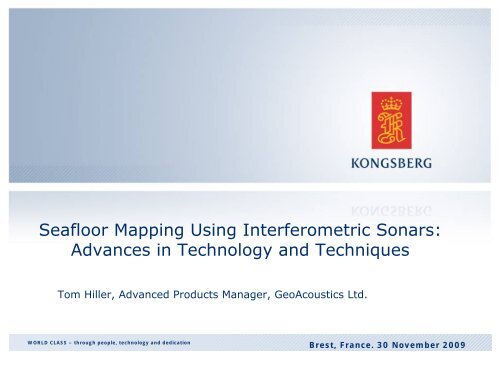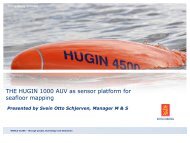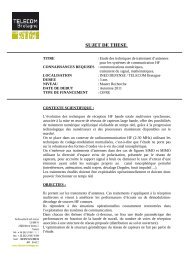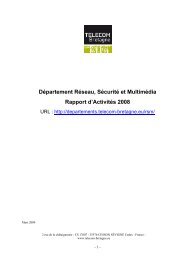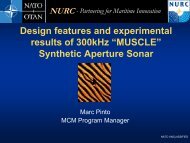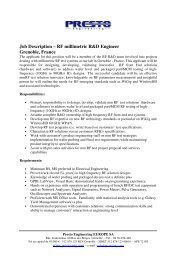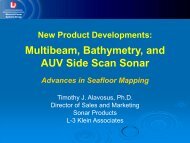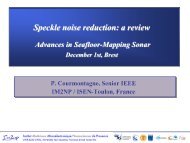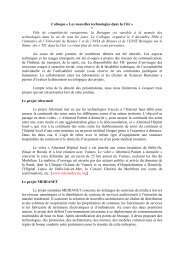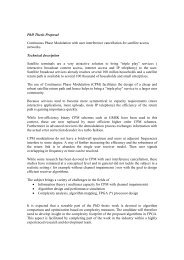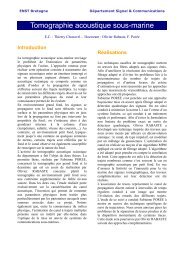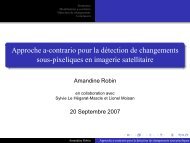Seafloor mapping using interferometric sonars
Seafloor mapping using interferometric sonars
Seafloor mapping using interferometric sonars
- No tags were found...
Create successful ePaper yourself
Turn your PDF publications into a flip-book with our unique Google optimized e-Paper software.
<strong>Seafloor</strong> Mapping Using Interferometric Sonars:Advances in Technology and TechniquesTom Hiller, Advanced Products Manager, GeoAcoustics Ltd.WORLD CLASS – through people, technology and dedicationBrest, France. 30 November 2009
Presentation Outline• Summary of the key attributes of <strong>interferometric</strong>technology• Requirements for high accuracy surveys• Examples of <strong>interferometric</strong> technology capabilities• Use of <strong>interferometric</strong> technology in ROVs and AUVs/ 2 / 30-Nov-09
Introduction to Interferometric Sonar Concepts and Technology/ 3 / 30-Nov-09
How does an interferometer work?• Transmitted pulse geometry similar to side scan• Multiple receive staves (typically 4)• Phase of returned sonar signal is measured on each stave• Differential Phase is used to determine return angle• Data is a time series (of angles, amplitudes, and otherattributes)/ 4 / 30-Nov-09
The data products:Side scan transmit geometrySimultaneous bathymetry andamplitude data (range series ofangles and amplitudes)/ 5 / 30-Nov-09
Principles of operationTransmit is short in time (a few cycles), wide across trackand narrow along track (like a side scan)Multiple receiver staves within each transducerPhase measurement based on differential timePhase difference (Ф)/ 6 / 30-Nov-09
Limitation: Interferometric Noise SourcesPhasor diagrams illustrating sliding footprint and sea noise effectsResult: <strong>interferometric</strong> raw data has angle noise/ 7 / 30-Nov-09
8 / 30-Nov-09Looking at the Raw Data in Detail:key feature: 1000s of data points/pingAccurate range, noisy angle
Basics of Interferometric Data ProcessingKey steps:Amplitude filtering▼Statistical filtering▼Binning/ 9 / 30-Nov-09
Summary of interferometer attributes:• Wide field of view (>240degrees)• Data density similar to digital side scan• Simultaneous bathymetry and side scan• Swath width is insensitive to roll• Higher data density away from nadir• Limited range due to signal to noise requirement for phasemeasurements• High data density but phase noise means processing is neededto get accurate seafloor depths• Able to be implemented in compact, robust, low power form- Particularly suitable for shallow water surveys from small vessels/ 10 / 30-Nov-09
11 / 30-Nov-09The GeoAcoustics GeoSwath Plus
GeoSwath Technology Timeline• GeoSwath 32 was introduced in 1998 by GeoAcoustics Ltd ofGreat Yarmouth, UK• GeoSwath Plus was launched Q4 2003• Continuous improvements in hardware and software havebeen improving data quality and swath width• Data has been accepted as meeting IHO standards, and beenincluded in UKHO Nautical Charts since 2005MilitaryOther• By mid-2009 over 120 systemsin use worldwideEnvironmentPorts &harboursOil&GasScientific/geologicalGeneralHydrographicDredging/ 12 / 30-Nov-09
GeoSwath Transducer Specifications:Frequency: 125kHz 250kHz 500kHzTxd dims: 60x25x8cm 30x15x6cm 25x11x6cmMax depth: 200m 100m 50mUsual use:0m – 200m capability10m-200m0m – 100m capability2m-50m0m – 50m capability1m-40mTypically foundon:Larger SurveyShipSmaller Vessel andlarger AUV/ROVSmall vessel &small AUV/ROV/ 13 / 30-Nov-09
GeoSwath Deployment ExamplesLarge and small vessels.Fixed, semi-permanent and temporary.Pole mount, hull mount.AUV and ROV mount./ 14 / 30-Nov-09
Suitable for very small survey vessels:/ 15 / 30-Nov-09
Achieving High Accuracy with Interferometric Data/ 16 / 30-Nov-09
GeoSwath Data Processing summary/ 17 / 30-Nov-09
Alternative Third Party Processing RoutesReal-timecontrolGeoSwath PlusOn-lineprocessingTransfer of flaggedraw data viaEthernet(real-time)HypackQINSYGeoSwath PlusAcquisitionHardwareDatastorage andtransferGeoSwath PlusOff-lineprocessingDataFlaggingandconversionto GSFDatafiltering andconversionto ‘reduced’raw fileFledermausSABREOther GSFreaderCARISFurther GS+ processingand export as xyzOther vendors/ 18 / 30-Nov-09
Unfiltered and filtered raw data/ 19 / 30-Nov-0919
All data view of single swath, 50m per side rangesetting, 5 Knots vessel speed/ 20 / 30-Nov-0920
Single swath binned at 50cm without interpolation orsmoothing, and sun illuminated/ 21 / 30-Nov-0921
High Data Density Ensures Survey QualityRaw Data1mGridBin size ≈ sonar footprint ≈ min. feature size. Data density > (or >>) 10 per bin./ 22 / 30-Nov-0922
500kHz GeoSwath: bathymetry and side scan coverage plotsWater depth ~10m under the transducers80m swath widthBathymetry:20cm grid/ 23 / 30-Nov-09Resolves 5cm high sand wavesSide-scan mosaic:10cm grid
24 / 30-Nov-09Standard deviation of filtered data
25 / 30-Nov-09Data density at different resolutions
Interferometric data processing for highaccuracy:• Key Characteristic: lots of data with accurate range andnoisy angle• In each depth bin may be 100s of measurements withapproximately independent noise and randomdistribution• Mean of this many depths gives a very repeatable andreliable number• Standard Error of the Mean = Standard Deviation of datadivided by the square root of the number of data pointsAccurate depths requires high data density, good datafiltering, and prudent binning/ 26 / 30-Nov-09
Running a Survey: the side scan search pattern/ 27 / 30-Nov-0927
The side scan search pattern gives full coveragehigh resolution <strong>interferometric</strong> surveys:/ 28 / 30-Nov-09930m x 780m, 8m to 25m deep, 2h survey time28
High accuracy surveying also requires:•Data Timing and Time Synchronisation:• Sub-ms PPS timing and use of time stamped ancillary data.•Navigation accuracy:• RTK GPS, or postprocessed position and attitude• Accurate sound velocity profiles• Minimise possible offset error sources:• Minimise lever arms• Align reference frame axes• Accurately measured offsets• Accurate ancillary data• Good calibration: multiple patch tests, cross-checksUsing above have demonstrated
Example of high accuracy river <strong>mapping</strong>:• Example is from Rijkswaterstaat; part of the DutchMinistry of Transportation and Water Management.• Responsibilities including the construction andmaintennance of waterways and flood prevention.• Chose the GeoSwath because it is particularly suitablefor the shallow rivers, canals and seas in Holland.• All the GeoSwath installations on RWS vessels are250kHz GeoSwath Plus configured with the QINSy realtime interface/ 30 / 30-Nov-09
31 / 30-Nov-09Vessel and retractable mounts
GeoSwath and QINSY-real time interface-into native QPS structure/ 32 / 30-Nov-09
Data Comparison Tests by Rijkswaterstaat• Same boat, same ancillaries, 2 fixed sonar mounts:GeoSwath 250kHz and Reson Seabat 8101• RTK GPS positioning and height control, Octans motionsensor• Surveys run alternately, same 4-line pattern;GeoSwath-8101-GeoSwath-8101• Processing separately:• GeoSwath via GS+ software• 8101 via QPS QINSY• GeoSwath via QINSY• Data compared in final grid/ 33 / 30-Nov-09
Detailed comparisons of 300m profilesGeoSwath1 vs GeoSwath2Beamformer1 vs Beamformer2GeoSwath1 vs Beamformer1GeoSwath2 vs Beamformer2Conclusion: GeoSwath and Beamformer results are as repeatableas each other via either processing route (within ~3cm)./ 34 / 30-Nov-09
Interferometer vs Beamformer Comparison on theRiver Meuse (1m bins)/ 35 / 30-Nov-09
Data suitable forengineering surveys ofrivers, canals and ports/ 36 / 30-Nov-09
Bathymetry and Sediment Classification Maps:Example of monitoring slow changes in sediment dump areaAivo Lepland, Reidulv Bøe, Aave Lepland, Oddbjørn Totland, "Monitoring the volume and lateral spread of disposedsediments by acoustic methods, Oslo Harbor, Norway", Journal of Environmental Management 90 (2009) 3589–3598/ 37 / 30-Nov-09
Another approach to height control:• GPS height <strong>using</strong> postprocessed navigation solutionCombine with inertial data to obtain full 3D GPS solution -remove effects of:• Squat• Vessel loading• Tide errors• Long period swell• Errors in the concept of ‘vessel centre ofrotation’/ 38 / 30-Nov-09
POS-MV SBET processing vs tide and heave2km line off NW Australia; ±10cm swell artefacts with ~12s period/ 39 / 30-Nov-09
Precise positioning allows multi-senor surveys of structures.Breakwater with bathymetry and LIDAR data combinedImages from U.S. Army Corp of Engineers, Field Data Collection and Analysis Branch, Coastal Hydraulics Lab./ 40 / 30-Nov-09
GeoSwath Plus for ROVs and AUVs/ 41 / 30-Nov-09
Why GeoSwath works well on AUVs and ROVs:• Intrinsic advantages of <strong>interferometric</strong>technology• Wide coverage even at low fly heights• Swath width insensitive to vehicle motion• Simultaneous bathymetry and Side Scan• Dimensions• Small, light and rugged transducers• Compact low power electronics• Communications• PC based - Windows XP• Ethernet and serial interfaces• Proprietary acquisition and processingsoftware package/ 42 / 30-Nov-09
43 / 30-Nov-09500KHz Transducers and Electronics
GeoSwath ROVSonar Receiversand controllerSonarTransmittersCompactPCEthernet InterfaceTiming, start, stopTiming etcSensor inputsAttitude etcOptionally alsoto dry-end PCTransducerTransducer/ 44 / 30-Nov-09
45 / 30-Nov-09GeoSwath Plus on Minerva ROV
46 / 30-Nov-09GeoSwath Plus on ROV
Sidescan and bathymetry/ 47 / 30-Nov-0947
48 / 30-Nov-09ROV Survey Data Bathymetry: Subsea ridge
GeoSwath AUVGeneric AUV application <strong>using</strong>Standard GeoSwath Electronics ModulesSonar Receiversand controllerSonarTransmittersCompactPCMemoryEthernet InterfaceTiming, start, stopTiming etcSensor inputsAttitude etcTransducerTransducerLocal controlleror self contained/ 49 / 30-Nov-09
AUV module electronics and transducers40cm/ 50 / 30-Nov-09
51 / 30-Nov-09GeoSwath on the Hydroid Remus 100 AUV
AUV swath width capability: >100m at 5m fly height/ 52 / 30-Nov-09
GeoSwath on the Gavia AUV2.6mPropulsion Control & Comms INS DVL GeoSwath Batt. Nose/ 53 / 30-Nov-09
Resolution of objects <strong>using</strong> 500kHz GeoSwath on smallAUV at 5m fly height./ 54 / 30-Nov-09
Pre-lay pipe trench survey <strong>using</strong> AUV-mounted GeoSwath1km/ 55 / 30-Nov-09
Harbour post-dredge survey <strong>using</strong> AUV-mounted GeoSwath100m/ 56 / 30-Nov-09
Portable AUVs for difficult deployments: under-ice <strong>mapping</strong>Location of APLIS ice camp: 73° N, 146° W in Beaufort Sea/ 57 / 30-Nov-09
58 / 30-Nov-09GeoSwath Plus on Gavia AUVUnder the Artic Ice
59 / 30-Nov-09Mission data
Maps of the underside of the Arctic ice(from M. Doble and P. Wadhams, University of Cambridge, UK)• Doble M. J. and Wadhams P. (2009) “First Through- Ice Use Of A Small Auv For Mapping The Arctic Sea Ice Underside.” GeoPhysicsResearch Letters• Doble M. J and Wadhams P. (2009) “Digital terrain <strong>mapping</strong> of the underside of sea ice from a small AUV” Journal of Atmospheric andOceanic Technology/ 60 / 30-Nov-09
61 / 30-Nov-09GeoSwath Plus on Gavia AUV, Bonaire 2008
Small AUV operationsOperations CentreSurvey areaVessel transit to site/ 62 / 30-Nov-09
63 / 30-Nov-09The edge of the coral reef
GeoSwath 500kHz SS from 2 lines at 15m fly height/ 64 / 30-Nov-09
65 / 30-Nov-09The AUV track lines down to 210m vehicle depth
66 / 30-Nov-09Wide swath width from a small AUV ….
67 / 30-Nov-09… with simultaneous co-registered side scan
Summary:• Interferometric technology has been shown to be suitable forhigh accuracy surveys, given proper survey planning, ancillaryequipment and data processing.• This technology is particularly suitable for small boat shallowwater applications and AUV/ROV deployment/ 68 / 30-Nov-09
Kongsberg Maritime/ 69 / 30-Nov-09


